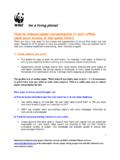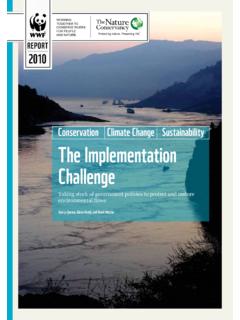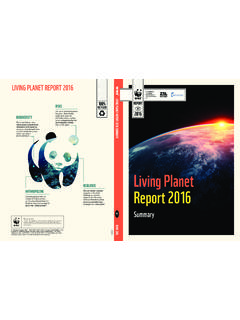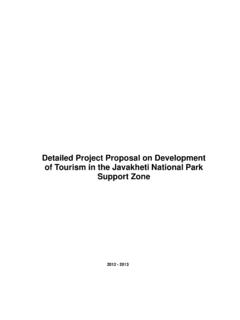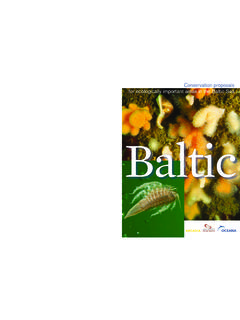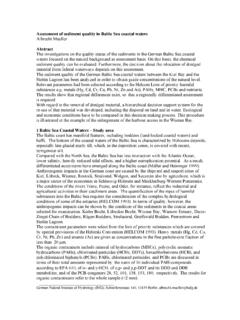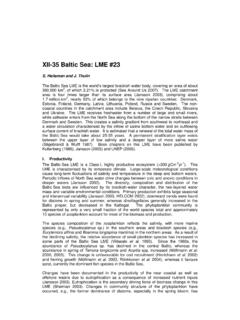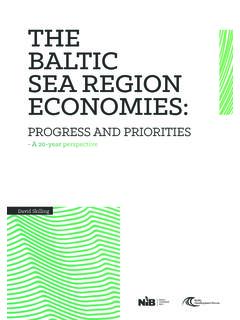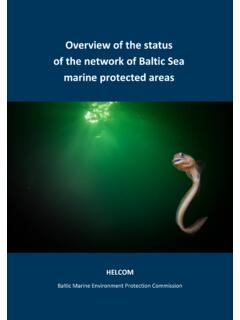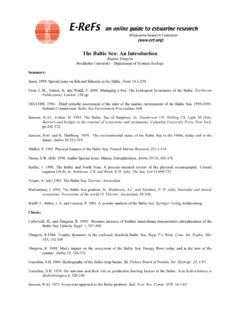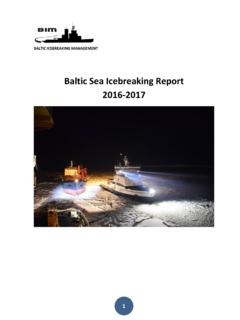Transcription of COUNTER CURRENTS - Panda
1 FUTURESCENARIOS2012 COUNTER CURRENTSSCENaRiOS fOR ThE baltic SEa TOwaRdS 20302 WWF baltic Ecoregion Programme COUNTER CURRENTS : Scenarios for the baltic SeaOver the past 100 years, the baltic Sea has changed and degraded quite dramatically. Human pressures today are so powerful that they are altering the ecological balance, depleting renewable resources beyond safe biological limits and jeopardizing future use of ecosystem goods and Even in a global context where sustainable management of natural resources in the sea lags far behind the terrestrial context, the baltic Sea presents a showcase of the mediocre performance of the surrounding coastal countries in balancing economic and social uses with the protection of the sea. Through WWF s collective work to develop, advocate and implement solutions to protect the baltic marine ecosystem and ensure the sustainable use of its resources, we have experienced firsthand the growing realization that our own futures and the future of the baltic Sea are inextricably linked.
2 The 2010 WWF report Future Trends in the baltic Sea 2a highlighted the substantial growth trends expected in the region over the next 20 years. A year later, WWF released its 2011 Scorecard report2b to evaluate the degree to which governments around the region were honouring their commitments to some of the most important environmental agreements and conventions designed to protect and manage the baltic Sea. The results were disappointing. These two reports succinctly illustrate two overwhelming challenges for the baltic Sea:1) the tremendous projected growth which will place even more demands on an already over-stressed ecosystem, and2) a governance framework that is not only unable to deliver the needed protection for the baltic Sea today but is clearly ill-equipped to meet the oncoming challenges. They demonstrate that the sheer scale of the challenges facing the baltic Sea requires a much broader engagement and action of both the public and private sectors than exists today.
3 Real leadership is desperately needed. It was with this in mind that WWF, with financial support from Trygg Hansa/RSA, launched this baltic Scenarios process in 2011, with the intention to facilitate a broad dialogue including both the public and private sectors. The focus has been to ask ourselves what kind of future we really want in the baltic Sea as a basis from which to begin to define what kind of commitments and action will be needed in order for us to reach this desired course we do not know what the future holds. Scenarios, however, help us describe possible futures, which is what this report aims to do. By describing what is possible tomorrow we believe we can better prepare ourselves for potential actions and responses today. Our focal question for this baltic Scenarios exercise has been: Possible futures for the use of the baltic Sea towards 2030. We have identified a suite of underlying trends that affect our focal question, some of which may be considered certain and other trends that are inherently uncertain.
4 Executive summaryThE baltic SEa iS a SEa Of ExTREmESThe baltic Sea is a sea of extremes the youngest sea on the planet, one of the world s largest brackish water bodies and one of the world s busiest maritime areas. It is a sensitive, dynamic and highly interdependent marine ecosystem, surrounded by nine countries with diverse political, social and economic realities and trends. It is fed by rivers and streams which drain an area more than 4 times larger than the sea itself, stretching from the Ukraine to Norway and home to more than 85 million people. 1 Ecosystem Health of the baltic Sea, 2010 HELCOM Initial Holistic Assessment, baltic Sea Environmental Proceedings No. 122, HELCOM2 a b -2011- Repor tiN 2010 aNd 2011 wwf RElEaSEd TwO REpORTS illUSTRaTiNg ThE OvERwhElmiNg ChallENgES faCiNg ThE baltic SEaWWF baltic Ecoregion Programme COUNTER CURRENTS : Scenarios for the baltic Sea3 The scenarios presented here are based on two overarching strategic uncertainties, which we have called Governance and Ecological Footprint.
5 These are uncertainties that we have deemed of the highest strategic importance in terms of their inf luence on the usage of and impacts on the baltic Sea. Thus trends and uncertainties provide the structure for our exploration of the an exploration of these trends on the directions that the baltic region could go in terms of Governance and Ecological Footprint, we emerge with four scenarios describing possible states for the baltic Sea region in 2030. In sum these are:Islands in the streamClear waters aheadShip-wreckedDangerous currentsLow ecological footprintHigh ecological footprintFragmented governanceIntegrated governanceThe scenarios presented here are based on two overarching strategic uncertainties, which we have called Governance and Ecological Footprint . Clear waters ahead (integrated governance, low ecological footprint): High levels of collaboration across and within governments and the private sector, combined with an enlightened awareness and acceptance of responsibility for the causes and consequence of ecological footprint, have led to a region that is close to an equilibrium measured against an aggregate of economic, social and environmental indicators.
6 There is a common sense of destiny and empowerment, even in the face of adversity. The baltic Sea s ecological resilience has improved slowly from the previous decades of neglect and mismanagement, with species and habitats showing strong signs of recovery alongside a thriving regional CURRENTS (integrated governance, high ecological footprint): Governments and companies have taken seriously their commitments and responsibilities to work together, recognizing the mutual gains to be had from collaboration. Yet this does not extend to the environmental sphere. The economic model of the late 20th century continues apace, treating environmental goods and services as externalities and measur-ing both corporate and national success on short term indicators. Ecosystem collapse has occurred on several fronts and more is imminent. Islands in the stream (fragmented governance, low ecological footprint): The web is the greatest resource and connector between the baltic Sea countries.
7 Due to several failures in cooperation, shifting foci and pressure from external sources, baltic Sea governments have lost the will to negotiate and collaborate. Without their leadership, regional sectoral initiatives have also largely dissolved. Yet at the individual level, people and companies have taken up the clarion call for one planet living . This has made some impact on the state of the baltic Sea environment, but it is simply not enough. Shipwrecked (fragmented governance, high ecological footprint): The region is characterized by fragmentation and mistrust. Political parties dominated by old-fashioned business interests are playing to old stereotypes to build protectionist walls and downplay any potential advantages to collaboration for the common cause. The environmental decline of the baltic Sea has accelerated, but the powers-that-be have positioned them-selves to benefit from rising prices and new business opportunities to sell alternatives for what was once a free and shared : Lasse BurellPhoto: Bernard RichterPhoto: Dainis DericsPhoto: Alain Lauga4 WWF baltic Ecoregion Programme COUNTER CURRENTS : Scenarios for the baltic SeaHaving developed these four possible scenarios for our interlinked economic, social and ecologically impacted futures, the question becomes, what next ?
8 The vast majority of the inf luences that will determine which of the possible futures is realized are human induced. We therefore have an enormous opportunity and responsibility. We can and must choose to act in a way that will take us toward the future we desire. Even inaction (or business as usual ) is a choice, albeit one that is likely to lead us to a future that many would deem hope that this report3 will spark an ongoing dialogue and serve as a catalyst for future collaboration, commitment and action to create the baltic we seek today, tomorrow and in 20 years. Let us work together and invent the future by: Recognizing that the basis for our future is dependent on securing ecosystem health, including ecological processes and services; Ensuring that governance of the sea is integrated and coordinated, within and between sectors and countries, as well as between agencies and ministries with different mandates; Showcasing good examples of leading individuals, industries and institutions who are already taking bold steps to secure and/or invest in a brighter future for the baltic so we can scale-up and make these examples the norm rather than the exception; Encouraging, incentivizing and supporting those individuals, industries and institutions who have not yet taken steps to advance but are eager to do so.
9 And Acting in partnership to collectively create a bright future for the baltic While this report reflects a diversity of inputs, WWF takes sole respons - ibil ity for the final content and recommend ations. ACRONYMSBSAP HELCOM s baltic Sea Action Plan CAP EU Common Agricultural PolicyCBD Convention on Biological DiversityCFP EU Common Fisheries PolicyEF Ecological FootprintEIA Environmental Impact AssessmentsETS EU Emissions Trading System on greenhouse gas emissionsEU European UnionMSFD EU Marine Strategy Framework DirectiveEUSBSR EU Strategy for the baltic Sea RegionGDP Gross Domestic ProductGIPSIs Greece, Ireland, Portugal, Spain, Italy HELCOM baltic Marine Environment Protection Commission (or Helsinki Commission)ICT Information and Communications TechnologyIPCC Intergovernmental Panel on Climate ChangeLNG Liquefied Natural GasMPA Marine Protected AreaMSP Maritime Spatial PlanningUN United NationsUNHDI United Nations Human Development IndexWBCSD World Business Council for Sustainable DevelopmentWEF World Economic ForumWWF World Wide Fund for NatureHuman pressures today are so powerful that they are altering the ecological balance, depleting renew-able resources beyond safe biological limits and jeopardizing future use of ecosystem goods and services.
10 Photo: Germund SellgrenWWF baltic Ecoregion Programme COUNTER CURRENTS : Scenarios for the baltic Sea5 WWF, with financial support from Trygg Hansa/RSA, initiated this work with Scenarios to create a shared under-standing of possible futures for the baltic Sea. A longer term goal is to secure commitments for action from the public and private sectors to work together toward the realization of our desired future and the sustainable management of this common, valuable but finite scenarios have a theme - a focal question which describes the area of interest and how far into the future they aim to describe. The focal question for this scenario work is: Possible futures for the use of the baltic Sea towards includes looking at future issues of the sea, as well as social, economic and ecological impacts of the possible uses of the baltic Sea. The process of developing the scenarios involved participants from most sectors and all countries around the baltic Sea.

